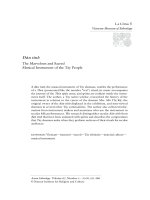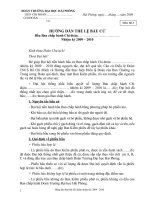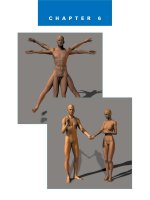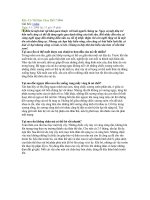Tài liệu Fruge drawing - The Definitive Body Foems ppt
Bạn đang xem bản rút gọn của tài liệu. Xem và tải ngay bản đầy đủ của tài liệu tại đây (5.74 MB, 40 trang )
&RQWHQWV
Introduction 7
7KH 'HILQ LWLYH%R G\ )R UPV
Shape-Masses of the Figure 9
Shape-Masses of the Head: Ball and Wedge 9
Barrel Shaped Rib Cage 12
The Wedge Box of the Pelvis 21
Column Forms of the Arms and Legs 26
Wedge Masses of Hand and Foot 37
)LJXUH1RWDWLRQ LQ'HHS6SDFH
The Torso is Primary 45
The Legs are Secondary 48
The Arms are Third in Importance 55
The Head is Last 59
Exercises in Notation 61
)LJXUH8QLW\LQ'HHS6SDFH,QWHUFRQQHFWL RQRIIRUPV
Overlapping Forms 65 Form Flow and Form
Unity 68 Interconnection Lines 68 Outline
and Contour 95 Tone Gradation 100
)LJXUH,QYHQWLRQ &RQWUROOLQJ6L]HLQ)RUHVKRUWHQHG)R UPV
Cylindrical and Barrel Forms 105
The Cylinder as a Rational Form 105
Finding Constant Factors 107
Width of Form as a Constant Factor 107
The Arms
The Hands 120
The Joints 127
)LJXUH,QYHQWLRQ &RQWUROOLQJ/HQJWK LQ)RUHVKRUWHQHG)R UPV
T he Circle in Space: T he Ellipse 135
The Joint as Pivot; The Member as Radius 136
The Isosceles Triangle Measuring Device 144
)LJXUH3URMHFWLRQ LQ'HHS6SDFH
P arallel P rojection of Solid Forms 152
Deep Space Projection of the Figure in Action 154
Figure Invention by Reversible Projection 156
Perspective Projection of the Figure 159
Phase-Sequence Projections: The Multiple Action Figure 165
Chin Thrust Leads Body Action 168
The Hand in Phase-Sequence Projection 174
&RQFOXVLRQ
174
,QGH[
175
,QWURGXF WLRQ
Most art students—and too many professional
artists—will do anything to avoid drawing the
human figure in deep space. Walk through the
life drawing classes of any art school and you'll
discover that nearly every student is terrified of
action poses with torsos tilting toward him or
away from him, with arms and legs striding
forward or plunging back into the distance;
twisting and bending poses in which the forms
of the figure overlap and seem to conceal one
another; and worst of all, reclining poses, with
the figure seen in perspective!
These are all problems in foreshortening,
which really means drawing the figure so that it
looks like a solid, three dimens iona l object
which is moving through real space—not like a
paper doll lying flat on a sheet of paper.
Drawing the figure in deep space fore-
shortening is not a mere technical trick, not a
mere problem to be solved;
it's the essence of figure drawing as perfected
by Leonardo, Michelangelo, Tintoretto,
Rubens, and the other great masters of the
Renaissance and Baroque eras.
But most art students would greatly prefer to
draw the figure as if it were a soldier standing
at attention, with the axes of the body and
limbs parallel to the surface of the drawing
paper, like a building in an architectural
elevation. Well, no, they don't UHDOO\ prefer to
draw it that way, but the dynamic, three
dimensional, foreshortened figure is so
forbidding that most students are inclined to
give up and stick to wooden soldiers—though
silently longing for some magic key to the
secret of foreshortening.
Burne Hogarth's '\QDPLF)L JXUH 'UDZLQJ
doesn't pretend to be a magic key-to-three-
dimens iona l-f igure-draw in g
in-ten-easy-lessons, but it is a magical book.
Here, for the first time, is a logical, complete
system of drawing the figure in deep space,
presented in step-by-step pictorial form. I've read
every figure drawing book in print (it's my job)
and I NQRZ that there's no book like it. The
system and the teaching method have been
perfected over the years in the author's classes at
the School of Visual Arts in New York, where
many of the dazzling drawings in this book —
immense, life-size figures which the artist LQYHQWV
without a model — were created before the eyes
of hundreds of awestruck students.
And surely the most stunning thing about
'\QDPLF )LJXUH 'UDZL QJ is that Burne Hogarth
teaches the UHDGHU to invent figures as the great
masters did. After all, Michelan gelo didn't ask
his models to hang from the ceiling or hover in
the air as he drew! He invented them—and this
is what the author demonstrates in the carefully
programmed series of drawings (with analytical
text and captions) that sweep across these pages
with the speed and graphic tempo of an animated
film.
'\QDPLF)LJXUH'UDZLQJ in the author's own
words, shows the artist "how to fool the eye, how
to depress, bend, and warp the two dimensional
plane" of the drawing paper so that a figure
drawing springs from the page in the same way
that the author's remarkable drawings bound
from the pages of this book. He demonstrates
how to create the illusion of roundness and depth
by light and shade, by the overlapping of forms,
by the transitions from one form to another, as
well as by the accurate rendering of individual
body forms. He explains how to visualize the
figure from every conceivable angle of view,
including the upviews and the downviews that
baffle students and professionals alike.
Particularly revealing are the multiphase
drawings — like mult iple e xposure
photographs—in which figure movement is
dissected, broken down into a series of
overlapping views of the body, "frozen" at
various stages of movement, so that the reader
can see how forms change at each critical
phase. Learning to see movement as a SURFHVV
the reader can draw the figure more
convincingly because he knows what happens
to body forms at each stage of the process. The
reader ultimately finds that he can SURMHFW the
figure—from any viewpoint and in any stage of
any action—as systematically as an architect
projects a building in a perspective drawing.
Burne Hogarth's achievement in '\QDPLF
)L JXUH 'UDZLQJ is the creation of a rational
system which eliminates the guesswork that
plagues every student of the figure. This system
isn't a shortcut, a collection of tricks to
memorize in order to produce stock solutions to
drawing problems—for nothing can make
figure drawing WKDW easy. The human figure
remains the most demanding of all subjects for
the artist. What '\QDPLF )L JXUH 'UDZLQJ
reveals is the inherent logic of the figure, and
the author proposes a system of study that is
built on this logic. The system takes time and
patience and lots of drawin g. You'll want to
reread '\QDPLF )LJXUH 'UDZLQJ many times.
Give this remarkable book the dedication it
deserves and the logic of the human figure will
finally become second nature to you. Your re-
ward will be that you go beyond merely
rendering figures — and begin to invent them.
Donald Holden
Figure drawing in depth is accomplished with
ease and authority only when the student
becomes aware of the characteristic body forms.
He must train his eye to see three kinds of forms
in the human figure: RYRLG forms (egg, ball, and
barrel masses); FROXPQ forms (cylinder and
cone structures); and VS D WXOD WH forms (box, slab,
and wedge blocks). These three kinds of forms
should be distinguished from one an
other and studied separately according to
their individual differences. Comparisons
should be made with respect to relative
shape, width, and length and special
emphasis should be placed on variations in
bulk, thickness, and volume. This is an
approach which seeks to define the body as
the har-monious arrangement and
interre lationship of its separate and
ind iv idua l defined parts.
7KH 'HILQLWLYH
%RG\)RUPV
At some point in the art student's development,
figure drawing reaches a stage where better
performance becomes the norm. With his work
at this level, the student may be able to draw a
variety of natural forms (those usually seen in
landscape and still life) in space. Capable as his
work appears at this point, the student should
develop a deeper insight into the forms and
interrelationships of the parts of the figure. He
may be thoroughly familiar with figure work in
conventional attitudes, with depicting the posed
movements and gestures of the art class model;
but these, if the student is aware, begin to look
predictably dull and static.
It takes a different kind of effort to conceive
and draw the figure in GHHS IRUHVKRUWHQL QJ in
form-over-form spatial recession. If the student
is called upon to show the unexpected and
unfamiliar actions of the body— those seen
from high or low angles he feels taxed to the
limit of his resources. At times, in direct
confrontation with the live figure, he may do
passably well by copying the model in the see-
and-draw studio method; but this approach is
not always successful or satisfying. To invent,
to create at will out of the storehouse of his
imagination—that is the challenge which so
frequently eludes the most intensive efforts of
the art student.
6KDSH0DVVHVRIWKH )LJXUH
The significance of foreshortened form lies in
describing three dimensional volume rather than
in delineating flat shapes. Our approach,
therefore, in
involves more than contour drawing only.
Since shape which is delineated only by
outline is two dimensional and has no volume,
it cannot express form in depth; but when the
forms of the figure are visualized as being
three dimensional in space, the result is a WKUHH
GLPHQVLRQDOVKDSH PD VV
Inherent in the concept of shape-mass is the
idea that the body is a defined mass, a three
dimensional volume existing in space and
depth, which is made up of a number of parts.
Each of these parts is also a three dimensional
volume existing in space and depth. It follows
that the figure is a multiform comp lex of
shape-masses, all independently formed and
all related. It will be our first task to research
the form properties of each of these shape-
masses which go into the formation of the
over-all shape-mass of the figure. In observing
the parts—the shape-masses — of the human
figure, we shall try to look at them from new
angles, from a series of changing viewpoints,
describing them especially with a "filmic"
concept of vision in motion.
6KDSH0DVVHVRIWKH +HDG
%DOODQG:HGJH
Different views of the head expose different
dominant forms. The cranial ball, for instance,
is usually considered fairly equal in size to the
lower facial wedge. This is especially apparent
in straight-on, front views. But when the
cranial ball is seen from an overhead angle, it
presents a far more impressive bulk than the
facial wedge.
As we observe the head from a high position,
from the top the crania vault dominates the
narrow, con stricted mass of the face coming
from under the projecting brow arch.
As our viewing angle becomes lower, the facial
mass tends to enlarge as the cranial mass
recedes.
Then, as our vantage point is raised once more,
this time in a right-to-left turn, the cranial mass
is once again dominant.
From a bottom view, the wedge of the face
takes on a more important appearance in
relation to the cranial structure. The features of
the face reveal a new aspect: looking upward at
the face from underneath, we see the under-
surfaces of the jaw, lips, nose, ears, and brow,
and these forms assert a commanding presence
over the side and frontal planes.
From the rear, the skull case and the facial
wedge show their most characteristic
differences in shape: the facial wedge, angular
and hard-cornered, is small when contrasted
with the larger, dome-shaped cranial mass.
11
%DUUHO6KDSHG5LE&DJH
The barrel shaped rib cage belongs the
class of RYRL G (rotund, egg, and ball shape)
forms. It is the largest sin form structure of
the entire bo Frontally, its curved surface
terminates top and bottom in two
horseshoe-like passages.
The descending collarbone depression of the
upper chest (left).
When the figure is tipped forward into a deep
frontal view, the swelling curve of the rib cage,
front to rear, is so great that it is able to girdle
the head within its encircling contour (below).
The cylindrical column of the neck emerges
like a thick, short tree limb growing from
within the triangulate hollow of the chest (left).
In any view looking upward, the barreling chest
mass dominates all other forms; like a curving
landscape, the pectoral arch overlaps the neck.
This torso, shown upview front, reveals how
much larger the mass of the chest is compared
with its attached members, the head and
shoulders.
14
The upper back, shown upview rear, is ample
enough to obscure the greater part of the head
and conceal the attachment of the neck column
to the chest.
The GHOWRLGV two large, inverted teardrop
shapes, descend from each side of the upper
chest mass. The deltoids are normally part of the
arms, but because they connect the arms to the
rib cage barrel, they become part of a unit des-
cribed as the FKHVWDQGVKRXOGHUV
16
When the FKHVW DQGVKRXOGHUV are considered
as a combined form, we must be aware of a
change in appearance in the upper chest mass:
with the arm down (A), the shoulder merges
with the chest (in this position, the upper torso
takes on the qualified appearance of a ZHGJH
and with the arm upraised (B), the shoulder
lifts from the chest, exposing a E DUUHO shape
(above).
Special note should be made of the drawing of
IHPDOH EUHDVWV on the rib cage. In general
appearance, the young adult female breast has
the look of an overturned teacup positioned at
the lower angle of the chest (above).
The diaphragm arch appears as a great, vaulting
tunnel of bone at the base of the front of the
chest. From this openin g, like the hollow
bottom of a brandy bottle, the long abdominal
mass emerges and descends in three undulant
stages, or tiers. It should be observed that the
terminal belly form (the third tier), starting at
the lower level of the navel and compressing to
the pubic arch, is not only the largest of the
three stages, but is roughly equivalent in size to
the frontal head mass of this figure (left).
To place the breast correctly, it is
necessary first to find the position of the QL SSOH
on the chest muscle. Using a male figure (for
the sake of clarity), we start at the pit of the
neck where the collarbones join (A). From this
point, we plot a curve at a 45° angle to the
vertical, central line of the body, which follows
the barrel shape of the rib cage and progresses
outward and down across the chest. The nipple
disc (B) is located on this line just above the
deep corner margin of the chest muscle.
If we draw two 45° lines outward
from the center body line to the right and to
the left across the chest barrel we can
correctly place the nipples of the chest base
(above).
When the cuplike breasts are superimposed
posed on the nipple positions, and the discs
are advanced to the surface of the breast
mounds, note that ERWK breasts point off the
curve of the chest at a FRPELQHG angle of 90°
(right).
three quarter view, they can QHYHU be seen
simultaneously from a direct, frontal position.
One breast will be seen with its centrally
located nipple disc face on, while the other will
be seen in a side view, with its nipple projecting
in profile.
In observing the full front view of the body,
note an interesting contradiction QHLWKHU
breast is seen frontally; ERWK breasts in this
case point DZD\ from the direct line of
vision in an off-angle outward direction.
Observe the positioning of the nipple discs;
check the 90° angle at the pit of the neck for the
correct placement of the nipples.
7KH :HGJH%R[RIWKH3HOYLV
The lower torso (the pelvic mass) has the
general shape of a wedge box, in direct contrast
to the upper torso (the rotund barrel of the rib
cage). After the rib cage, the pelvic wedge is
the second largest mass of the body. Locked to
the barrel by the tapering muscles of the waist,
the wedge box is narrow at the top, broader at
the base.
Schematic rendering of the two torso masses:
the wedge box of the pelvis and the barrel of the
rib cage.
In the normal, erect attitude of the body, the two
torso masses express an inverse, counterpoised
relat ionsh ip:
the barrel is tipped back, the shoulders are
drawn rearward, and the chest facade is
exposed.
Here, the lower pelvic wedge is tipped forward,
the underbelly is recessive, and the rear buttock
area arches upward into view.
In a rear view of the lower torso wedge, the
pelvic region is seen as a compound form with
a EXWWHUIO\ shape. The wide gluteusmedius
masses, under the arched hipbones, form the
XSSHU wings (A, Al), and the thick gluteus
maximus masses (the buttocks) form the close-
set XQGHU wings (B, Bl).
The butterfly wedge easily indentifies the pelvic
wedge masses in this rear, almost side, view.
The wing forms are overlapped and
foreshortened from front to back.
The butterfly configuration is evident in a rear
view of the mature female pelvic mass. Note
the relatively larger hip structure, both in width
and in bulk, compared to the upper chest mass.
A narrow rib cage combined with a wide pelvis
identifies the female torso and is a
distin gu ish ing characteristic of male-female
differentiation.
result is a compound, torso which assumes the
simp lified form of a massive NL GQH\ shape
(above).
The kidney shape of the combined
torso masses is characterized by the
distinctively narrow waist of the body the
flexible central axis between the upper torso
(the rib cage barrel) and the lower torso (the
pelvic wedge). The waist, because of its axis-
like quality, is capable of great versatility of
movement.
< In this series of sketches, the butterfly device is
shown to be an easily established point of
reference and an aid in drawing any rear view
of the pelvic forms of the lower torso (left).
&ROXPQ)R UPVRIWKH$U PVDQG/HJV
The arm and leg masses have a general
sim ilarity and correlation of form. Described
simply, the arm and the leg are elongated,
jointed two-part members, each of whose parts
has a modified cone or cylinder shape.
Note that both the arm and the leg swivel, or
rotate, high in the shoulder (A) or hip (Al); both
have a bending, or rocking, joint in the middle
of the member at the elbow (B) or the knee (Bl);
and both have a terminal gyrating member, the
hand or the foot, attached to a tapered base at
the wrist (C) or the ankle (C1).
decidedly different structural rhythms. In the
arm, for example, a consistent XSZDUGFXUYL QJ
rhythm is present along the entire XQGHUDUP
length from shoulder to elbow, and from elbow
to wrist (see arrows).
The curving rhythm of the arm in a rear view.
The elbow turns out; therefore, the underarm
lifts and the line takes a clear RYHUFXUYH
28
The clue to the underarm curve is found in the
position of the HOERZ Locate the elbow, and
you will be able to trace the line upward toward
the rear armpit; the lower line can be followed
from the elbow down to the base of the outer
palm. No matter how the arm moves, from
simple positions, such as the two extended arms
shown above right, to deep, active bends (left),
the consistent undercurve is always present.
Invariably, this curve provides the basis for the
arm's structural rhythm.
A frontal figure with arms flexed and
foreshortened shows the correlation of double
curves (see arrows).









